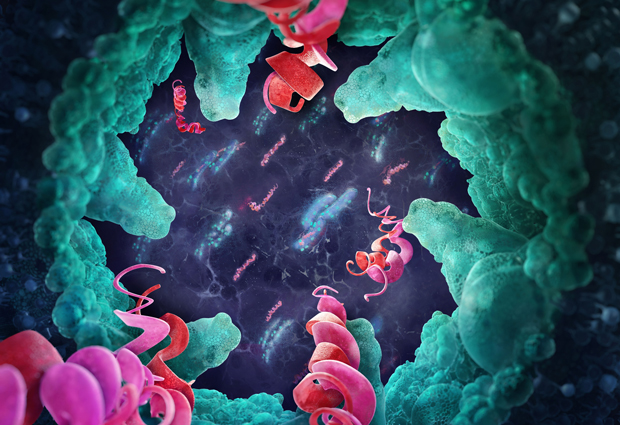
Read the latest Issue
EMBL scientists add crucial knowledge to understanding of the biology of bacterium that causes tuberculosis

In a paper published this week in Nature Microbiology, the Wilmanns group at EMBL together with scientists from across Europe reveal the overall architecture of an assembly of proteins known as Type VII secretion systems found in a group of bacteria which cause diseases such as tuberculosis.
“These results represent a big step forward in our understanding of how some of the deadliest pathogenic bacteria such as Mycobacterium tuberculosis function,” says head of EMBL in Hamburg, Matthias Wilmanns. “Our ambition is to use this as a basis to investigate secretion as a mechanism by which mycobacteria infect and interact with the human host.”
New drugs are urgently needed in the fight against tuberculosis as the bacteria responsible for causing the disease becomes increasingly resistant to current antibiotics. According to the World Health Organisation, tuberculosis resulted in 1.8 million deaths and 10.4 million new infections in 2015, making it one of the top 10 causes of death in humans worldwide.
The bacterium responsible, Mycobacterium tuberculosis (Mtb), has a complex biology and a comprehensive understanding of this is crucial to inform the development of new drugs. “Mtb relies heavily on Type VII secretion systems, or T7SSs, to transport molecules across its cell membrane upon infection, disarming and damaging the host cell,” explains staff scientist Annabel Parret who coordinated the research at EMBL. “Due to their crucial role, these secretion systems are important targets for much needed new drugs”, adds Parret. Drugs designed to block these systems could stop the pathogen in its tracks. However, just how these secretion systems work is poorly understood.
In total, five T7SS systems are found in mycobacteria. Known as ESX-1 to ESX-5, these systems are all very similar but each transport specific molecules. In this new study, electron microscopy (EM) data collected by Thomas Marlovits’ group at the IMP-IMBA Vienna allowed the first reconstruction of a functional ESX-5 T7SS, consists of a large assembly of 4 types of protein that form a ring around a central pore. Although the T7SS was predicted to span the entire cell envelope allowing the direct transfer of molecules from the bacterium to the host, the results show that the mycobacterial T7SS structure sits exclusively in the inner bacterial membrane. “This suggests there must be additional components to help move the molecules across the second layer of the cell membrane,” explains Kate Beckham, a fellow in the EMBL Interdisciplinary Postdoc Programme who worked on the biochemical and biophysical characterisation of the complex.
“The particular challenge during the structural analysis was that the sample contains a rigid core from which flexible domains project away,” says Luciano Ciccarelli, post-doctoral fellow in the Marlovits group, who worked on the structure determination by single-particle analysis. The EMBL team collected Small Angle X-ray Scattering (SAXS) data at the EMBL SAXS beamline on the DESY campus in Hamburg to help understand what the flexible protein domains look like and how these parts of the secretion system might move. “We believe these arm-like proteins help to move the molecules of different shapes and sizes from the inside of the bacterial cell towards the pore of the secretion system for them to be transported out of the cell,” says Beckham. Further biochemical and genetic experiments carried out by the group of Edith Houben and Wilbert Bitter at the Vrije Universiteit Amsterdam support the structural data and provide in vivo insights into the components required for assembly of the secretion system.
Looking for past print editions of EMBLetc.? Browse our archive, going back 20 years.
EMBLetc. archive